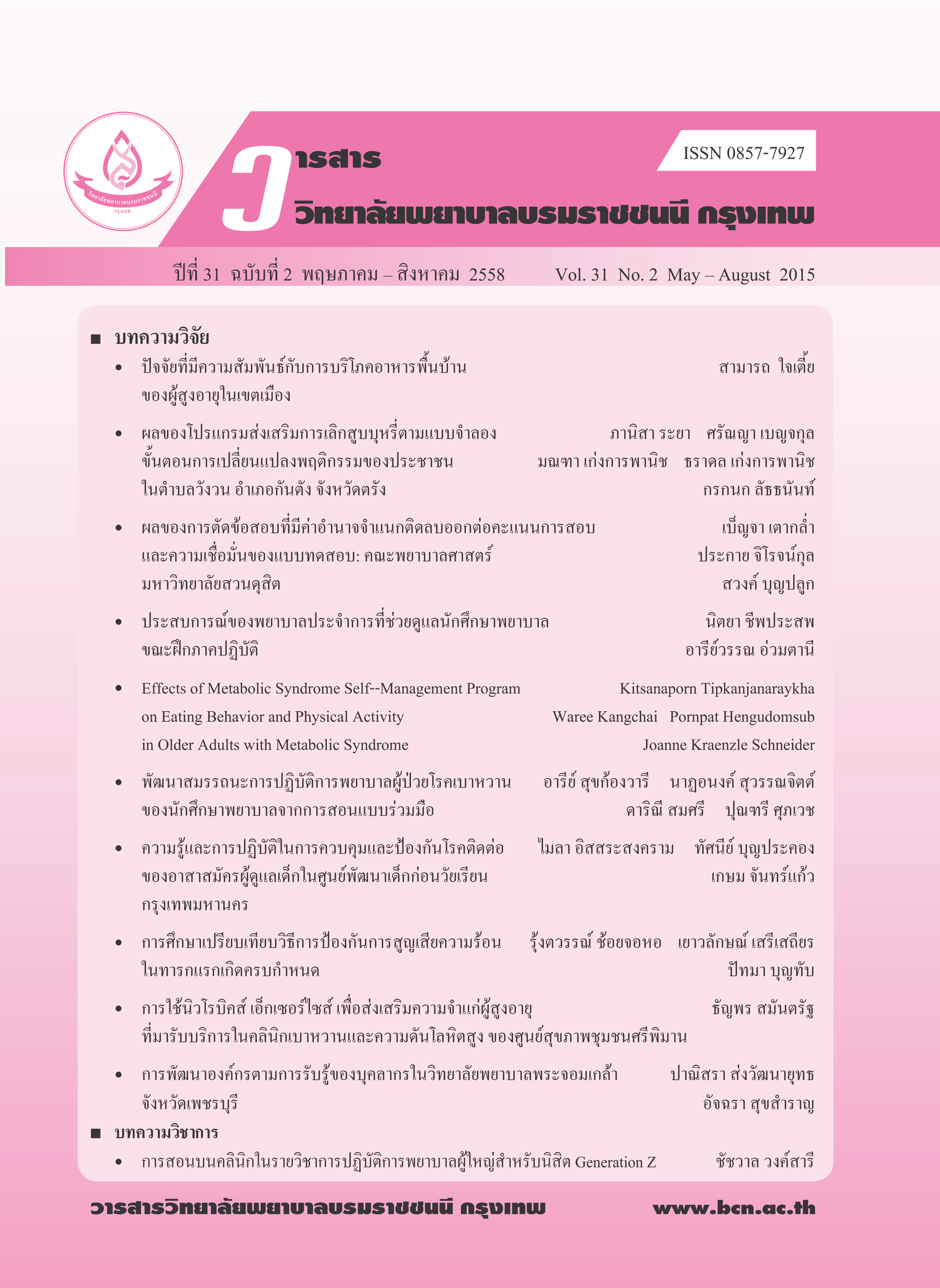การพัฒนาหลักสูตรฝึกอบรมเพื่อเสริมสร้างสมรรถนะการพยาบาล ด้านภัยพิบัติสำาหรับนักศึกษาพยาบาล
คำสำคัญ:
หลักสูตรฝึกอบรม, สมรรถนะการพยาบาลด้านภัยพิบัติ, นักศึกษาพยาบาล, training curriculum, disaster nursing competency, nursing studentบทคัดย่อ
การวิจัยนี้เป็นการวิจัยและพัฒนา มีวัตถุประสงค์เพื่อเสริมสร้างสมรรถนะการพยาบาลด้านภัยพิบัติของนักศึกษาพยาบาล มีขั้นตอนการพัฒนาหลักสูตร 4 ขั้นตอน มีรายละเอียด ดังนี้
ขั้นตอนที่ 1 การศึกษาข้อมูลพื้นฐาน พบว่าหลักสูตรการสอนของสถาบันพระบรมราชชนกไม่พบรายละเอียดเกี่ยวกับการพยาบาลด้านภัยพิบัติ ในขณะที่สภาการพยาบาลสากลกำหนดสมรรถนะการพยาบาลด้านภัยพิบัติ 4 ระยะ คือ 1) ระยะป้องกันและลดความรุนแรง/ผลกระทบ 2) ระยะการเตรียมความพร้อม 3) ระยะการตอบสนองและการรับมือ และ 4) ระยะการฟื้นฟูสภาพภายหลังเกิดภัยพิบัติ จากการสอบถามความคิดเห็นของพยาบาลวิชาชีพพบว่าสมรรถนะการพยาบาลด้านภัยพิบัติมีความสำคัญระดับมาก และประชาชนมีความต้องการสมรรถนะการพยาบาลด้านภัยพิบัติระดับมาก สอดคล้องกับอาจารย์ผู้สอนและผู้เชี่ยวชาญ ด้านการจัดการภัยพิบัติที่ระบุว่า ควรต้องมีการพัฒนาสมรรถนะการพยาบาลด้านภัยพิบัติ
ขั้นตอนที่ 2 การสร้างหลักสูตรฝึกอบรม เพื่อพัฒนาสมรรถนะการพยาบาลด้านภัยพิบัติของนักศึกษาพยาบาล ให้ผู้ทรงคุณวุฒิพิจารณาความเหมาะสมและความสอดคล้องของหลักสูตรฝึกอบรมพบว่ามีความเหมาะสมอยู่ในระดับมากและมีความสอดคล้องกันทุกองค์ประกอบของหลักสูตรฝึกอบรมอยู่ในระดับมาก
ขั้นตอนที่ 3 การทดลองใช้หลักสูตรฝึกอบรม พบว่าประสิทธิภาพของหลักสูตรฝึกอบรมผ่านเกณฑ์ความสัมพันธ์ระหว่างกระบวนการและผลลัพธ์โดยเฉลี่ยตามเกณฑ์ 80/80 เมื่อนำไปทดลองใช้โดยใช้กับนักศึกษาพยาบาลจำนวน 30 คน เป็นเวลา 16 ชั่วโมง พบว่า คะแนนเฉลี่ยความรู้และเจตคติของนักศึกษาพยาบาลหลังการใช้หลักสูตรฝึกอบรมสูงกว่าก่อนการใช้หลักสูตรฝึกอบรมอบรมอย่างมีนัยสำคัญทางสถิติที่ระดับ .01 รวม ทั้งมีทักษะการพยาบาลด้านภัยพิบัติอยู่ในระดับมาก
ขั้นตอนที่ 4. การปรับปรุงแก้ไขหลักสูตรฝึกอบรม ปรับปรุงเนื้อหาและสื่อวิดิทัศน์เกี่ยวกับการพยาบาลด้านภัยพิบัติ
ABSTRACT
The purpose of this research and development study was to build disaster nursing competencies for nursing students. The four phases of the curriculum development were as follows: 1) The investigation of baseline data included the content of teaching and learning activities of the curriculum, current situation of disaster, disaster nursing competencies, and the suggestion from stakeholders; 2) The development of the training curriculum comprised 3 steps: draft the training curriculum, examine the draft, evaluate the curriculum, and improve the curriculum; 3) The implementation of the training curriculum to the nursing students of Boromarajonani College of Nursing, Suratthani; and 4) the improvement and revision of the training curriculum. The results revealed that:
Step 1: The investigation of baseline data showed that the curriculum of the Praboromarajchanok Institute does not include the disaster nursing content whereas the International Council of Nurses (ICN) specify disaster nursing competencies for 4 phases including: 1) Prevention/mitigation, 2) Preparedness, 3) Response, and 4) Recovery/rehabilitation. Nurses perceived that disaster nursing competencies were highly important. People in the community required nurses who had high competencies in disaster nursing. It was consistent with opinions from experts and nurse instructors, which indicated that the disaster nursing competencies needed to be developed.
Step 2: The development of the training curriculum to promote disaster nursing competencies for nursing students. The appropriateness and consistency of the curriculum was evaluated by experts and it showed high appropriateness and consistency for the entire component of the curriculum.
Step 3: The implementation of the training curriculum revealed the effectiveness of the curriculum that ensured the existence of a relationship between processes and outcome by following the criteria 80/80. The curriculum that consists of 16 hours training was used to 30 nursing students. The results revealed that the mean score of the knowledge and attitude of nursing students were significantly different at 0.01 statistics level, and their skills were at good level.
Step 4: The improvement and correction of the traing curriculum includes the content of disaster nursing the media which is emphasized on the development of positive attitudes.
Downloads
Downloads
เผยแพร่แล้ว
How to Cite
ฉบับ
บท
License
บทความที่ได้รับการตีพิมพ์ เป็นลิขสิทธิ์ของวารสารวิจัยสุขภาพและการพยาบาล (วิทยาลัยพยาบาลบรมราชชนนี กรุงเทพ) ไม่สามารถนำไปตีพิมพ์ซ้ำในวารสารฉบับอื่น

















